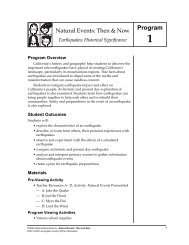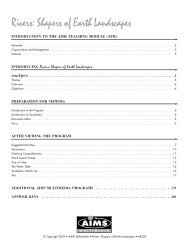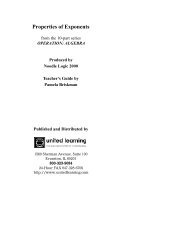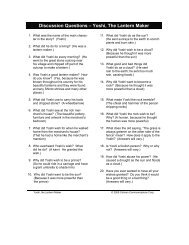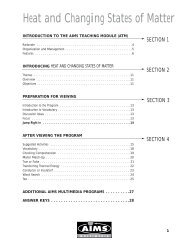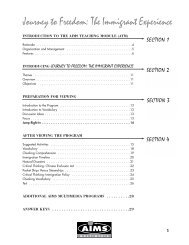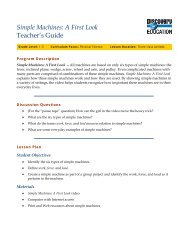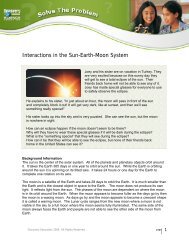Climate, Landscapes and Life: The Tropics - Discovery Education
Climate, Landscapes and Life: The Tropics - Discovery Education
Climate, Landscapes and Life: The Tropics - Discovery Education
Create successful ePaper yourself
Turn your PDF publications into a flip-book with our unique Google optimized e-Paper software.
SUGGESTED ACTIVITIES<br />
Writing <strong>and</strong> Connection to Biology<br />
<strong>The</strong> tropics are vibrant, sensual regions. Ask students to use their five senses <strong>and</strong> their imaginations to explore the<br />
tropics. Have students each choose a tropical region, then work individually to write a paragraph, short essay, or<br />
short story answering such questions as: What would you see there ... colors, shapes, people, animals, plants,<br />
buildings What tastes would you expect ... sweet, sour, spicy, bitter What smells would you expect ... odors that<br />
assault you, fragrances that entice What sounds would you expect ... languages, music, traffic, animals, waves,<br />
quiet noises or loud ones What would you expect to feel ... would the air be warm or cool ... windy or calm ...<br />
rainy or dry ... what textures would your surroundings have, your food ... how do you think your emotions would<br />
feel Encourage students to use highly descriptive, picturesque language in their writing. Ask for volunteers to share<br />
their writings with the class.<br />
BIOLOGY<br />
30-60 Minutes<br />
Meeting Individual Needs<br />
Have students work alone or in small groups to look up the words alluvial, drought, monsoon, <strong>and</strong> tropical in the<br />
dictionary or other resource. What are the definitions of the words What is an example of each (alluvial refers<br />
to soils that have been deposited by running water, as in a river delta; drought refers to an extended period without<br />
rainfall, <strong>and</strong> can be experienced in desert regions; a monsoon is a wind which brings torrential rains, particularly<br />
in south <strong>and</strong> south east Asia; tropical refers to regions that lie between the Tropic of Cancer <strong>and</strong> Tropic of<br />
Capricorn, have little seasonal change in the length of days <strong>and</strong> nights, <strong>and</strong> sea level temperatures that do not drop<br />
below freezing, such as Hawaii, most of Mesoamerica, South America <strong>and</strong> Africa.)<br />
35 Minutes<br />
Connection to Geography <strong>and</strong> Earth Science<br />
Hurricanes are truly the storms of the tropics, <strong>and</strong> the period of June 1 through November is “hurricane season”<br />
in the Caribbean, Central America, Mexico, <strong>and</strong> the eastern <strong>and</strong> gulf coasts of the United States. Have students<br />
work in small groups to define <strong>and</strong> explain: what a hurricane is, where <strong>and</strong> how hurricanes are formed; the roles<br />
played by warm, humid ocean air, wind patterns, <strong>and</strong> air pressure play in the formation of a hurricane; the parts<br />
of a hurricane; the size of a hurricane as defined by the Saffir-Simpson Hurricane Scale <strong>and</strong> the damages caused<br />
by one; <strong>and</strong> storm rotation (the Coriolis effect). Assign a team to track the hurricanes of the current season. Post a<br />
large map of the tropics in the room <strong>and</strong> have the team plot each storm’s latitudinal <strong>and</strong> longitudinal progress.<br />
<strong>The</strong>y can also keep an eye out by way of the many Hurricane Watch websites on the Internet. Request that the<br />
team, or its spokesperson report periodically to the class.<br />
Extended<br />
GEOGRAPHY<br />
EARTH<br />
SCIENCE<br />
Connection to Multiculturalism <strong>and</strong> to Foreign Language Classes<br />
In most of the countries of the tropics the national language is a tongue other than English. Ask students who are<br />
fluent in (or who are studying) a language spoken in the tropics to compose a short paragraph in that language<br />
describing a day in the life of people from that region <strong>and</strong> to provide a translation into English. Ask for volunteers<br />
to first read their paragraphs in the original language, followed by their English translation.<br />
45 Minutes<br />
FOREIGN<br />
LANGUAGE<br />
Connection to History<br />
<strong>The</strong> various regions of the tropics are l<strong>and</strong>s rich in history. Divide the class into four groups, assigning each group<br />
one of the four tropical regions: rainy tropics, wet-dry <strong>and</strong> monsoon tropics, tropical <strong>and</strong> subtropical deserts, <strong>and</strong><br />
tropical highl<strong>and</strong>s. Have each group research their region to create a timeline of significant historical occurrences,<br />
then have a volunteer from each group present their findings to the class.<br />
HISTORY<br />
60 Minutes<br />
7<br />
© Copyright 2002 • AIMS Multimedia • <strong>Climate</strong>, <strong>L<strong>and</strong>scapes</strong> <strong>and</strong> <strong>Life</strong>: <strong>The</strong> <strong>Tropics</strong> • #2650



